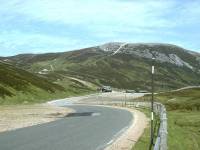 |
I've taken the 9.30 bus up to
Glenshee, one
of Scotland's four skiing centres, It's eight miles south of Braemar on
the main A93 Perth road. The road climbs to a height of nearly 2000ft,
and is the highest classified motor road in Britain. On one side is the
Cairnwell group, three Munros said to be the most accessible in
Scotland.
On the other side, the east side, is Glas Maol and its outliers.
According
to the guidebooks it should be possible to pick off at least four, and
possibly six, Munros in one outing. Nothing ventured...
Pictured here is the highest point
of the
Glenshee road with Carn Aosda behind. The posts are snow markers.
|
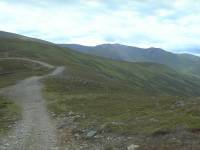 |
The path to Glas Maol starts from
the southeast
corner of a large gravel carpark and rises up the unappetising slopes
of
mat grass |
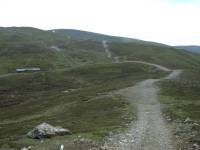 |
The path rises to the top of a
minor ridge
then descends into a hollow populated with ski-centre outbuildings.
These
apparently thrive during the winter, but during the close season they
look
like abandoned expedition bases in the Arctic tundra. |
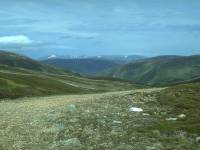 |
The peaks of the eastern Cairngorms
come
into view to the north as the path climbs. |
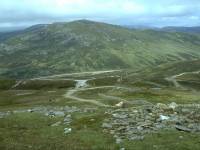 |
Thanks to the elevation of the road
there
is a climb of only around 1500ft to Glas Maol, which puts it in the
same
category as an average Lakeland mountain ascent in terms of effort
involved.
Already half way up here, looking back at the Glenshee development with
the Cairnwell (3061ft) behind. |
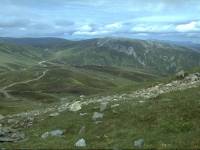
|
Carn Aosda, with the central
Cairngorms behind,
from the ascent path to Glas Maol. |
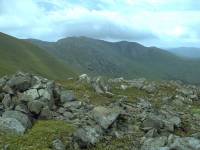
|
That's Creag Leacach in view, a
Munro of
3238ft and Glas Maol's neighbour to the south. Despite the forecast of
a bright day the clouds are already building to the south and east. |
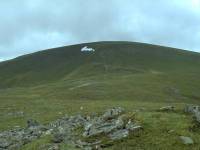
|
The ski developments are left
behind and
the bare summit of Glas Maol (3504ft) looms ahead. The name means,
"bare
grey-green hill". The patches of snow lingering into June show how
harsh
the climate is here on the high tops. |
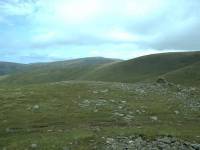
|
Carn of Claise, Glas Maol's
northern neighbour,
seen across the intervening moorland. |
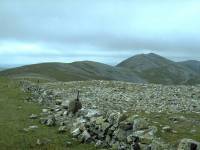
|
From the moorland shelf seen in the
image
above a clear path lead southeastwards at an easy gradient and progress
is swift. However, it soon became apparent that it wasn't going to
ascend
Glas Maol but was heading for the col between it and Creag Leacach to
the
south. Having got here I reckoned I would go on to climb Leacach first.
The intervening ridge is unusual in the Highlands in carrying a
drystone
wall and the remains of a fence. |
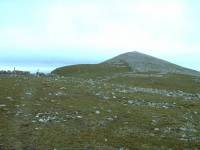
|
The Creag Leacach ridge is
characterized
by coarse, angular scree and the ground soon becomes rocky. |
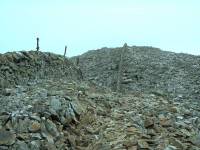
|
The summit ridge of Creag Leacach
is a boulder
field more reminiscent of the top of Ben Nevis. Cloud is descending,
and
the summit of Glas Maol behind me is already in mist. So much for the
weather
forecast. |
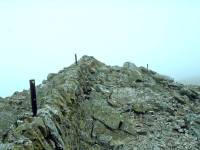
|
The summit of Creag Leacach,
3238ft, Scotland's
159th highest mountain and my eleventh Munro. |
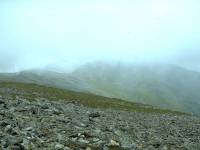
|
The cloud arrives just in time to
hide the
view. I'm not sure if this is the ridge south of the summit or the view
northwards to Glas Maol.
Maol disappeared from view even as I
began
to retrace my steps along the ridge, and I resigned myself to yet
another
aborted Scottish walk. But I reckoned that, while I was up here, I
might
as well ascend Maol at least. The ridge was broad and flat, and all I
had
to do was keep walking uphill until I got to the summit.
|
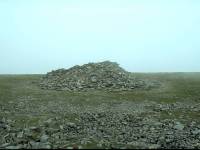
|
The summit of Glas Maol, Scotland's
69th
highest mountain at 3540ft (or 1068 meters). The boundaries of
Perthshire,
Angus and Aberdeenshire meet here.
My twelfth Munro, and a great pity
that all
around is eerie silence and mist. There is a scattering of people
around and one of them asks me if I've seen any dotterel. I reply
truthfully
that I wouldn't recognize a dotterel if one fell on me.
|
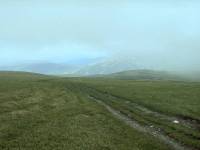
|
A debate. Abandon the walk or try
for a third
summit? I still can't see anything but according to the map there is a
clear track most of the way to Carn of Claise. It's just a matter of
walking
east or northeast off the summit of Glas Maol for a couple of hundred
meters.
I fish out the compass and wander into the misty silence. Two minutes
later
I find the path, one of the old drove roads that crosses the Mounth
plateau,
and known as the Monega pass. There's a hint of the cloud lifting again. |
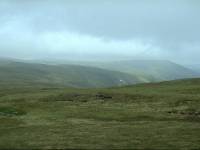
|
I'm glad I decided to press on, for
the path
is easy (if a little wet in places) and tantalising glimpses of distant
summits appear every few minutes as the cloudbase comes and goes. The
Monega
pass forks, and I take the right turn across a plateau-like ridge to
the
east. |
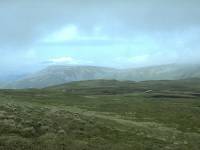
|
The path reaches the environs of
Carn of
Claise. A further summit, that of Cairn an Tuirc, looms briefly out of
the cloudbase. |
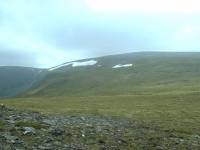
|
Suddenly, a more general clearance.
Glas
Maol reappears in the scene behind to the southwest, the view enlivened
only by the crags of Little Glas Maol to the left. |
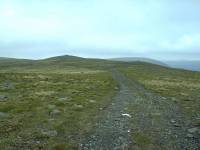
|
The Monega pass heads on across the
plateau.
This is more like the Pennine Way than the Highlands and the walking is
swift and easy. |
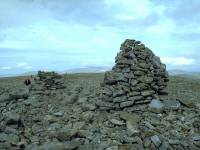
|
Two and a half kilometers northeast
of Glas
Maol the Monega pass skirts Carn of Claise just a hundred meters to the
east. It's a simple, though momentarily steep, pull up a brief rocky
slope
to the summit. Munro number thirteen, and the first time I've ever
climbed
three in one outing. Carn of Claise is an anglicised form of the
original
Gaelic name meaning "hill of the hollow". Its elevation is 3491ft,
Scotland's
71st highest summit. |
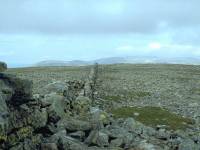
|
A stone wall heading north
northeast from
Carn of Claise. I sat and had lunch here, during which time two more
groups
of hikers visited the summit from the north. |
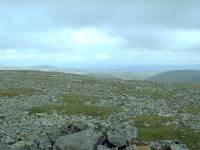
|
The plateau stretches out to the
east, and
is so uniform that it's difficult to put a name to any other feature
even
with a map and compass to hand. Somewhere out there, across an area of
bog known as Ca Whims, are Tom Buidhe and Tolmount, mere swellings in
the
plateau and among Scotland's least spectacular mountains.
I decided that if I couldn't even
make out
which of the many summits in view were Tom Buidhe and Tolmount, it
probably
wasn't a good idea to attempt to climb them. I decided that Cairn an
Tuirc,
to the northwest, was going to be my fourth and last summit of the day.
|
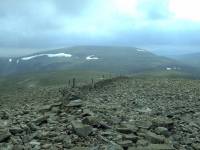
|
The drystone wall peters out after
a couple
of hundred yards. Glas Maol overlooks the scene. |
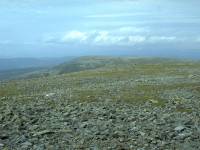
|
Both the OS and Harvey's maps
insist that
there is a discontinuity in the path but it is apparent enough here,
and
is easily picked up. I had a sudden inspiration. Where did this path
end
up? A look at the map revealed that it was to descend into Glen
Callater
just two miles from Braemar, which looked like a far more agreeable
alternative
than the guidebook's suggested descent to the road from Cairn an Tuirc. |
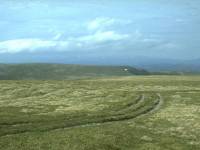
|
The Monega pass heading northwards
and approaching
the lip of the Coire Loch Kander. |
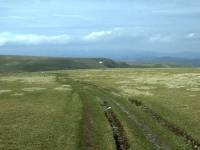
|
The Coire Loch Kander looks quite
spectacular
on the map, a ring of craggy walls breaking the plateau and descending
steeply to a little blue lochan. A shame, then, that it's missed out
entirely
by the excursion to Cairn an Tuirc. |
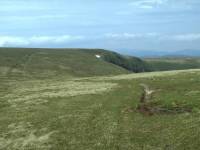
|
A brief glimpse of what I might
have seen... |
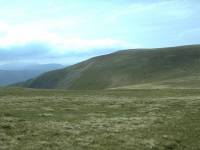
|
...before turning left for the
fourth Munro
of the day. There's a reascent of only 200ft from Carn of Claise to
Cairn
an Tuirc and its a simple diversion off the path over short, firm turf. |
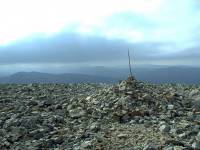
|
The summit ridge itself is
abysmally stony
but it wasn't long before I hit Cairn an Tuirc's topmost point, this
cairn
of 3343ft elevation at the western end of the ridge. This is Scotland's
113rd highest point. |
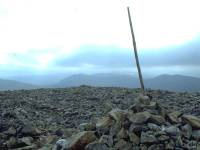
|
The Glenshee hills backlit by the
afternoon
sun. |
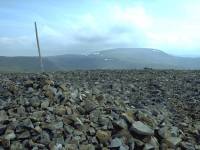
|
Glas Maol from the summit of Cairn
an Tuirc.
The name means "hill of the boar". |
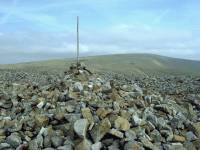
|
Carn of Claise from the summit. |
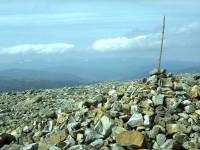
|
...and northwards to Beinn a
Bhuiridh in
the Cairngorms. |
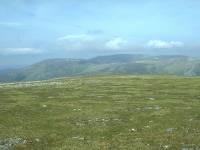
|
Time to leave. I walked back along
the stony
ridge to the eastern top then dropped diagonally off the ridge to the
north.
It's firm, easy turf here and it should be a simple matter of curving
around
the lip of the mountain's northern flank to pick up the Monega Pass
again. |
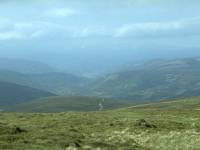
|
I've not hit the pass yet but I can
see its
course lower down, with Glen Callater and Braemar beyond. |
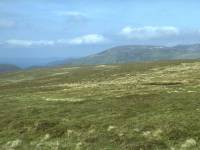
|
Carn an t-Sagairt Mor, a Munro on
the far
side of Glen Callater and an outlier of Lochnagar. |
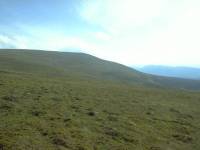
|
The view back to Cairn an Tuirc as
I continue
to contour round the slope. |
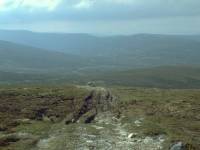
|
The Monega Pass is reached at last.
An easy
walk now all the way back to Braemar, five miles away. |
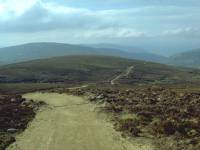
|
After a small area of confusion the
track
gains a "made" surface that looks as though it will become a forest
ride
in a few years' time. |
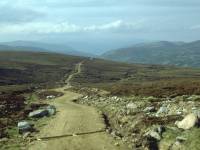
|
There's no danger of losing this
path, Many
would argue that it is visually intrusive in this landscape. You
certainly
don't have a feeling of wilderness here. |
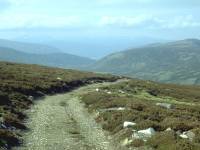
|
After a couple of miles the path
reaches
the lip of a steeper slope... |
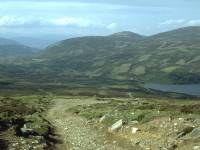
|
...revealing Loch Callater set
below in the
glen. |
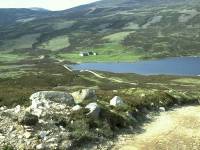
|
The path twists and bucks a little
but the
loch is soon reached. |
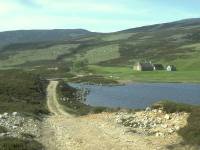
|
I neared Lochcallater Lodge. A path
along
the lochside leads up into the glen and provides an approach to
Tolmount
and the Lochnagar group. |
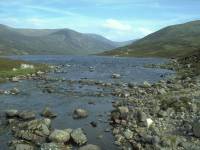
|
Loch Callater, with Carn Bannoch
(another
of the Lochnagar Munros) behind. |
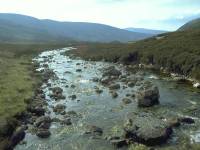
|
The Callater burn issuing from the
loch. |
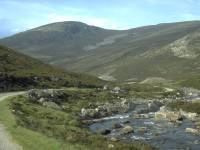
|
Lower Glen Callater provides a
picturesque
ending to the walk. |
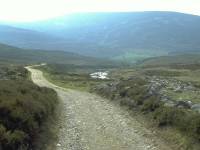
|
The glen turns a corner to look
across to
Morrone, which stands above Braemar. |
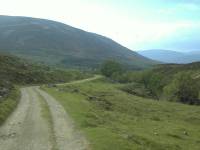
|
The track approaches the first
stand of trees... |
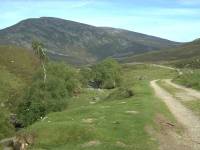
|
...which provide a nice afternoon
picnic
spot before the glen comes out onto the main road two miles short of
Braemar. |
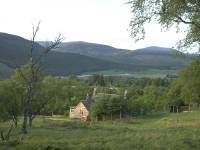
|
These two images don't really
belong here,
but what the heck... it's about nine in the evening after the Glas Maol
walk and I've climbed to Woodhill, on the lower slopes of Morrone,
southwest
of Braemar. This is the view northeastwards towards Culardoch. |
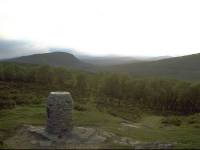
|
...and this is the view
northwestwards into
the evening sun. The cloud is descending again but according to the
topograph
in front the central Cairngorm peaks would normally be visible from
here.
Oh well, someday I'll find out. |
![]()